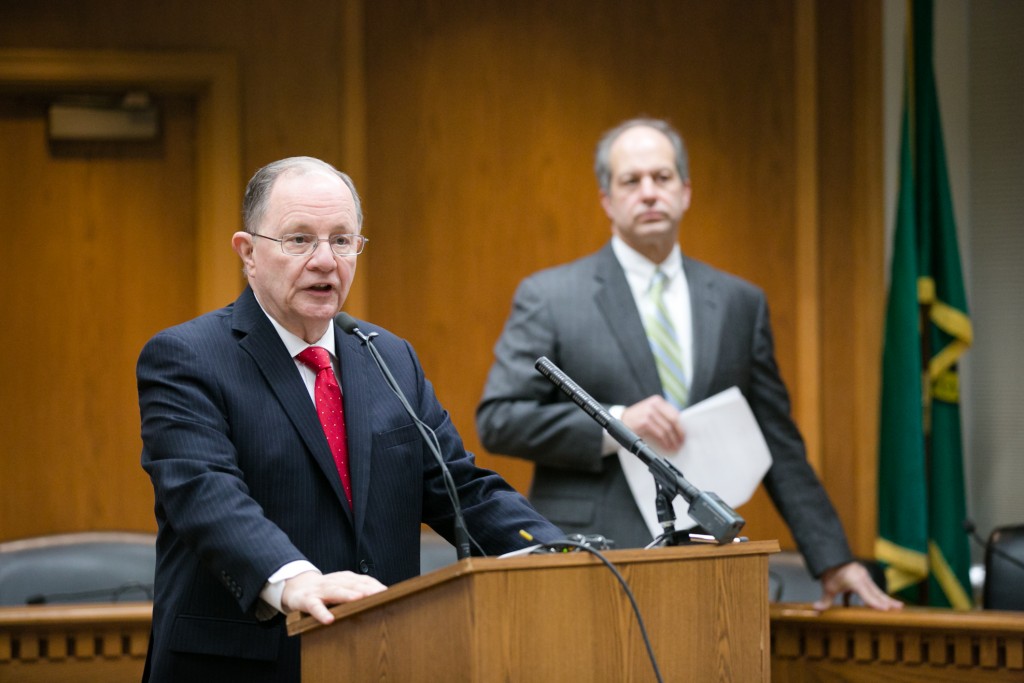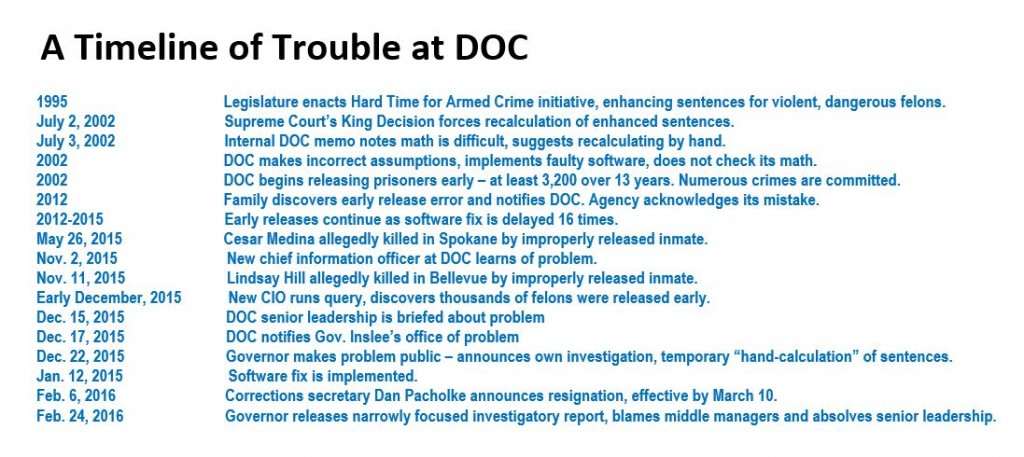Senate investigates early release of thousands of inmates
Lawmakers demand accountability in a horrific case — more than 3,000 released, two victims dead

Sens. Mike Padden, R-Spokane Valley, and Steve O’Ban, R-Tacoma, hold a press conference regarding the Senate’s Department of Corrections investigation, February 22, 2016.
One of the most horrific cases of state-government negligence in Washington history became a top concern for lawmakers in 2016 — a sentencing fiasco at the Department of Corrections that caused thousands of inmates to be released before their sentences were finished, with tragic results. A Senate investigation placed the blame where it belongs — on the Department of Corrections officials who ignored the problem after it was called to their attention, and the officials in the governor’s office who shut their eyes to the obvious warning signs of mismanagement at the agency.
At least two people are dead as a result of the Department of Corrections’ error, but the full extent of the carnage remains unknown. As of this posting in June 2016, six months after the problem was revealed to to the public, the agency still has not determined the exact number of inmates released — somewhere in the neighborhood of 3,000. Nor has it fully examined crimes they committed and arrests that took place when they should have been behind bars. This is one of many gaps identified by the Senate investigation, the only independent inquiry into the issue.
Using subpoena powers and working with the assistance of outside counsel, the Senate Law and Justice Committee spent four months investigating the issue. It released a 66-page report on May 25, together with supporting documents that allow the public to check its work.
The problem started in 2002, when the Department of Corrections reprogrammed its computers to account for “good time,” to comply with a new state Supreme Court ruling. Trouble was, the agency’s interpretation was wrong. As a result it began releasing prisoners early — over the next 13 years, more than more than 3,000 of them. These prisoners were among the most dangerous in the state — those convicted of armed crimes, or crimes involving a sexual motivation; robbers, rapists and murderers. These felons were released an average two months early; in one case, nearly two years.
In 2012, the father of an assault victim finally took five minutes to double-check the department’s math and recognized that his son’s attacker was due to be released six weeks early. His call to DOC should have launched an immediate effort to fix the problem agency-wide. Instead, the agency fixed that one case, scheduled a computer fix to cover all the rest, didn’t bother recalculating sentences in the meantime, and failed to follow up to make sure the correction actually was made. Communication within the department was so poor that the issue was forgotten for more than 3 years — more than a third of those released were turned loose during this period, including the inmates who have been linked to the two deaths.
The Senate investigation found that agency executives, led by former Secretary Bernie Warner, were aware of the early-release problem in the weeks that followed that phone call — some of them knew about it in quite extensive detail. Some even recognized the potential for disaster. Yet none did anything about it. Warner knew enough about the issue to take further action. The same is true of a policy director for the agency, Sandy Mullins, who later became the official who advised the governor on Department of Corrections issues. Mullins also failed to make inquiries. The governor’s office ignored other red flags as well, including reorganizations within the department that ran counter to accepted management principles, heavy turnover in the IT department that signaled poor leadership.
The lack of curiosity by the governor’s office might also be explained by the fact that Warner was in the midst of a personal relationship with a high-ranking official on the governor’s staff. A reporting arrangement devised by the governor’s office failed to address the obvious conflict. Tough questions went unasked, and an agency that performed a vital public safety mission was left adrift.
The Senate investigation determined that DOC during this period diverted its attention, time and resources to a grandiose computer project that still has not been completed. This “next-generation” risk-assessment software project contained a number of questionable elements, including Warner’s decision to award the development contract to a personal friend with a criminal record, and the agency’s efforts to award a no-bid “sole source” contract despite the availability of other contractors who could do the work. Ultimately the agency found a way to avoid rules restricting such contracts, by amending and extending an old maintenance contract so that it covered development work.
Recommendations in the Senate report included further investigation of the contracting process, possible sanctions against Warner, and a new recognition by the Department of Corrections that its prime duty is public safety.
Earlier, the governor’s office released a much more limited report on the same issue. The governor’s office exonerated agency executives, ignored its own responsibility, said other management issues were unimportant — and placed blame on middle managers. Nevertheless, a spokesperson for the governor’s office claimed the Senate report said nothing new.
As Sen. Mike Padden, chair of the Senate Law and Justice Committee, told reporters, “The problems started at the top.”
Final report of the Senate Law and Justice Committee
Majority report on Deparment of Corrections investigation and supporting materials
“Senate report on deadly prison releases blames Corrections execs, governor’s office” — This announcement summarizes findings of the Senate’s independent investigation into the Department of Corrections debacle. May 25, 2016.
PowerPoint presentations on Department of Corrections investigation
DOC — Overview — Early Release Debacle
DOC — Responsibility of Warner and Executive Branch
DOC — Warner’s Misplaced Priority — STRONG-R
DOC — Warner’s Troubled Contractor — Assessments.com
DOC — Governor’s Report — Errors and Omissions
Other explanatory materials
“Committee chair calls on governor to accept responsibility for deadly prison releases” — A disappointing response from the governor’s office leads Senate Law and Justice chair Padden to call on the governor to do the right thing. May 26, 2016.
“One-page summary — testimony reveals flaws in governor’s DOC report” — This brief summary outlines the immediately apparent discrepancies between the governor’s report on the DOC debacle and the testimony the Senate has gathered in its independent investigation. March 1, 2016.
“Why the Legislature needs its own investigation of Corrections case” – This op-ed by Sens. Mike Padden, R-Spokane Valley, and Steve O’Ban, R-Pierce County, lays out the reasons the Senate felt it necessary to conduct an independent investigation, despite political opposition from Gov. Jay Inslee. Originally published in the Seattle Times, Feb. 24, 2016.
“From the front lines at the Department of Corrections” – This document summarizes some of the responses generated by the Senate’s “FixDOC” program, which asked Department of Corrections employees for their insight into the management problems at the agency. Workers describe a culture of intimidation and fear, discouraging them from reporting problems regarding agency management. Feb. 22, 2016.
“History of Legislature exercising subpoena powers” – The Senate’s investigation of the Department of Corrections is one of the rare times the Legislature has exercised its subpoena powers. Here are some of the other cases. Jan. 15, 2016.
Day-to-day news about the Corrections case
“Error at DOC puts public, law enforcement at risk” – Sen. Mike Padden, chair of the Law and Justice Committee, reacts as the Department of Corrections debacle is made public. Dec. 22, 2015.
“Hearing will air concerns about Department of Corrections, early release of prisoners” – Sen. Padden announces the Law and Justice Committee will seek testimony from Corrections Secretary Dan Pacholke on the opening day of the 2016 legislative session. Jan. 7, 2016.
“Accountability chair targets ‘culture of apathy’ responsible for Corrections’ early release of criminals” – Sen. Mark Miloscia, R-Federal Way, announces hearings, legislation to address management lapses at the Department of Corrections. Jan. 11, 2016.
“Senate Law and Justice Committee to seek subpoena in Department of Corrections case” – Sens. Padden and O’Ban announce the Law and Justice Committee will seek subpoena authority to obtain records from the Department of Corrections and the governor’s office. Jan. 14, 2016.
“Rules Committee will consider subpoenas in DOC case” – The Law and Justice Committee approves a resolution seeking two subpoenas, and lays out the rationale for an independent investigation. Next the Rules Committee must consider subpoenas. Jan. 19, 2016.
“Senate Majority Leader issues statement on decision to seek subpoenas” – Sen. Mark Schoesler, R-Ritzville, calls the bipartisan 13-7 vote from the Senate Rules Committee an historic decision. Jan. 19, 2016.
“Senate majority announces plans for Corrections investigation” – Sens. Padden and O’Ban announce plans for hearings and call for employee input in the “FixDOC” program. An investigating attorney is named. Jan. 28, 2016.
“Padden: Pacholke resignation will not deter Senate investigation of DOC” – Sen. Padden reacts to the surprise resignation of Corrections Secretary Dan Pacholke. Feb. 6, 2016.
“Senate Accountability chair responds to Corrections Secretary resignation” – Sen. Miloscia observes that Dan Pacholke’s parting comments are a symptom of the problem at the Department of Corrections. Feb. 6, 2016.
“Miloscia accountability plan for Corrections passes Senate” – Sen. Miloscia discusses the passage of a bill requiring the Department of Corrections to implement performance-management strategies. Feb. 17, 2016.
“Senate begins formal hearings on Corrections fiasco, releases thousands of documents” – The Senate announces the release of thousands of documents relating to the Corrections case that have been obtained under subpoena. Feb. 22, 2016.
“Governor’s DOC report incomplete, senators say” – Sens. Padden and O’Ban react to a disappointing report from the governor’s office that absolves senior managers of all reponsibility, placing all blame on middle managers and on inadequate procedures for updating DOC software. Feb. 25, 2016.
“Miloscia response to governor’s report on DOC investigation: ‘Take a deeper look’” – Sen. Miloscia says he is surprised by the limited scope of the governor’s report. The governor’s investigation of his own agency clearly failed to consider its “culture of apathy,” he says. Feb. 25, 2016.
“Investigatory hearing delayed after eye-opening testimony in Corrections case” — At the first investigatory hearing after the release of the governor’s report, witnesses challenge its accuracy. Senators postpone the next hearing to study inconsistencies in the governor’s account. Feb. 29, 2016.
“Senators: Testimony reveals flaws in governor’s DOC report” — Sens. O’Ban and Padden offer a quick summary of the discrepancies between the governor’s report and the testimony the Senate has received in public session. March 1, 2016.
“More witnesses dispute governor’s report on Department of Corrections” — Five witnesses dispute the governor’s account. March 17, 2016.
“Senate Corrections investigation turns to Warner” — Sen. Padden discusses a new public records request directed at former Corrections Secretary Bernie Warner. March 23, 2016.
Investigation Materials
Witness statements, exhibits in Corrections case – organized by hearing date
February 22, 2016
Proposed Committee Rules for Department of Corrections Investigation
Department of Corrections Organization Charts
Wendy Stigall, Department of Corrections employee, interview
Ronda Larson, Washington Assistant Attorney General, interview
Sue Schuler, Department of Corrections employee, interview
Senate Investigation Exhibit 1
Senate Investigation Exhibit 2
Senate Investigation Exhibit 3
Senate Investigation Exhibit 4
Senate Investigation Exhibit 5
Senate Investigation Exhibit 6
Senate Investigation Exhibit 7
Senate Investigation Exhibit 8
Senate Investigation Exhibit 9
February 25, 2016
Doug Hoffer, former employee of Department of Corrections, interview
Mark Ardiel, employee of Sierra-Cedar, interview
Peter Jekel, former employee of Department of Corrections, interview
Ira Feuer, Chief Information Officer of the Department of Corrections, interview
Senate Investigation Exhibit 11
Senate Investigation Exhibit 12
Senate Investigation Exhibit 13
Senate Investigation Exhibit 14
February 29, 2016
Kit Bail interview
Denise Doty interview
Dan Pacholke interview
Senate Investigation Exhibit 15











